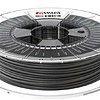Hi there !
I’m planning to upgrade my printer from a proprietary hotend that only accepts brass nozzles, to the e3d chimera in combination with stainless steel nozzles. However I heard, that stainless steel nozzles don’t transfer as much heat/time to the filament, meaning you have to print slower in order to heat the material properly.
Now to my question: How much volume/sec did you use while still getting good results ?
The formular is: layer heigth x layer width x printspeed in mm/s = volume/sec
Also I’d like to know, if the carbon fibre influences the way, that XT handles overhangs and bridges.
For example the metal blends by colorfabb (i love those, have gotten 1,5kg brass recently):
Due to the metal in the material the filament heats up quicker and cools down faster, the faster heating means that higher speed is possible and the faster cooling means, that overhangs of up to 80° (in my testing, small parts managed even 85°) will still work out, also longer bridges are possible.
Wood and bamboo don’t really influence these characteristics of the normal material, however maybe the carbon fibres do.
So the second question is: Do you see differences in printing overhangs/bridges or other specialities when comparing XT to XT CF-20 ?
Lastly I’d like to know, how the material behaves when sanding or drilling it. I’ve printed alot (5kg within 4 months) with XT Clear and it’s sandable, drillable etc. does XT CF-20 behave differently ? Also it would be nice to know how the optic changes when sanding the material.
I hope you can answer some of those questions, if not that’s no problem as I can contact the Colorfabb support, however they want to sell their product so it’s more reliable to ask independent testers, that know the everyday-struggle of 3d printing and have experience with (maybe) other materials, beside the Colorfabb ones.
Those drones look great, good luck with that !
Cheers,
Marius
 Cheers!
Cheers!